91
34
I always used a Mandelbrot image as the 'graphical' version of Hello World in any graphical application I got my hands on. Now it's your guys' turn.
- Language must be capable of graphical output or drawing charts (saving files disallowed)
- Render a square image or graph. The size at least 128 and at most 640 across*
- The fractal coordinates range from approximately -2-2i to 2+2i
- The pixels outside of the Mandelbrot set should be colored according to the number of iterations before the magnitude exceeds 2 (excluding* black & white)
- Each iteration count must have a unique color*, and neighboring colors should preferably be easily distinguishable by the eye
- The other pixels (presumably inside the Mandelbrot set) must be colored either black or white
- At least 99 iterations
- ASCII art not allowed
* unless limited by the platform, e.g. graphical calculator
Allowed:

Disallowed:

(shrunken images)
Winning conditions:
Shortest version (size in bytes) for each language will get a mention in this post, ordered by size.
No answer will ever be 'accepted' with the button.
Leaderboard:
/* Configuration */
var QUESTION_ID = 23423; // Obtain this from the url
// It will be like https://XYZ.stackexchange.com/questions/QUESTION_ID/... on any question page
var ANSWER_FILTER = "!t)IWYnsLAZle2tQ3KqrVveCRJfxcRLe";
var COMMENT_FILTER = "!)Q2B_A2kjfAiU78X(md6BoYk";
var OVERRIDE_USER = 17419; // This should be the user ID of the challenge author.
/* App */
var answers = [], answers_hash, answer_ids, answer_page = 1, more_answers = true, comment_page;
function answersUrl(index) {
return "https://api.stackexchange.com/2.2/questions/" + QUESTION_ID + "/answers?page=" + index + "&pagesize=100&order=desc&sort=creation&site=codegolf&filter=" + ANSWER_FILTER;
}
function commentUrl(index, answers) {
return "https://api.stackexchange.com/2.2/answers/" + answers.join(';') + "/comments?page=" + index + "&pagesize=100&order=desc&sort=creation&site=codegolf&filter=" + COMMENT_FILTER;
}
function getAnswers() {
jQuery.ajax({
url: answersUrl(answer_page++),
method: "get",
dataType: "jsonp",
crossDomain: true,
success: function (data) {
answers.push.apply(answers, data.items);
answers_hash = [];
answer_ids = [];
data.items.forEach(function(a) {
a.comments = [];
var id = +a.share_link.match(/\d+/);
answer_ids.push(id);
answers_hash[id] = a;
});
if (!data.has_more) more_answers = false;
comment_page = 1;
getComments();
}
});
}
function getComments() {
jQuery.ajax({
url: commentUrl(comment_page++, answer_ids),
method: "get",
dataType: "jsonp",
crossDomain: true,
success: function (data) {
data.items.forEach(function(c) {
if (c.owner.user_id === OVERRIDE_USER)
answers_hash[c.post_id].comments.push(c);
});
if (data.has_more) getComments();
else if (more_answers) getAnswers();
else process();
}
});
}
getAnswers();
var SCORE_REG = /<h\d>\s*([^\n,<]*(?:<(?:[^\n>]*>[^\n<]*<\/[^\n>]*>)[^\n,<]*)*),.*?(\d+)(?=[^\n\d<>]*(?:<(?:s>[^\n<>]*<\/s>|[^\n<>]+>)[^\n\d<>]*)*<\/h\d>)/;
var OVERRIDE_REG = /^Override\s*header:\s*/i;
function getAuthorName(a) {
return a.owner.display_name;
}
function process() {
var valid = [];
answers.forEach(function(a) {
var body = a.body;
a.comments.forEach(function(c) {
if(OVERRIDE_REG.test(c.body))
body = '<h1>' + c.body.replace(OVERRIDE_REG, '') + '</h1>';
});
var match = body.match(SCORE_REG);
if (match)
valid.push({
user: getAuthorName(a),
size: +match[2],
language: match[1],
link: a.share_link,
});
else console.log(body);
});
valid.sort(function (a, b) {
var aB = a.size,
bB = b.size;
return aB - bB
});
var languages = {};
var place = 1;
var lastSize = null;
var lastPlace = 1;
valid.forEach(function (a) {
if (a.size != lastSize)
lastPlace = place;
lastSize = a.size;
++place;
var answer = jQuery("#answer-template").html();
answer = answer.replace("{{PLACE}}", lastPlace + ".")
.replace("{{NAME}}", a.user)
.replace("{{LANGUAGE}}", a.language)
.replace("{{SIZE}}", a.size)
.replace("{{LINK}}", a.link);
answer = jQuery(answer);
jQuery("#answers").append(answer);
var lang = a.language;
lang = jQuery('<a>'+lang+'</a>').text();
languages[lang] = languages[lang] || {lang: a.language, lang_raw: lang, user: a.user, size: a.size, link: a.link};
});
var langs = [];
for (var lang in languages)
if (languages.hasOwnProperty(lang))
langs.push(languages[lang]);
langs.sort(function (a, b) {
if (a.lang_raw.toLowerCase() > b.lang_raw.toLowerCase()) return 1;
if (a.lang_raw.toLowerCase() < b.lang_raw.toLowerCase()) return -1;
return 0;
});
for (var i = 0; i < langs.length; ++i)
{
var language = jQuery("#language-template").html();
var lang = langs[i];
language = language.replace("{{LANGUAGE}}", lang.lang)
.replace("{{NAME}}", lang.user)
.replace("{{SIZE}}", lang.size)
.replace("{{LINK}}", lang.link);
language = jQuery(language);
jQuery("#languages").append(language);
}
}body {
text-align: left !important;
display: block !important;
}
#answer-list {
padding: 10px;
width: 290px;
float: left;
}
#language-list {
padding: 10px;
width: 290px;
float: left;
}
table thead {
font-weight: bold;
}
table td {
padding: 5px;
}<script src="https://ajax.googleapis.com/ajax/libs/jquery/2.1.1/jquery.min.js"></script>
<link rel="stylesheet" type="text/css" href="https://cdn.sstatic.net/Sites/codegolf/all.css?v=ffb5d0584c5f">
<div id="language-list">
<h2>Shortest Solution by Language</h2>
<table class="language-list">
<thead>
<tr><td>Language</td><td>User</td><td>Score</td></tr>
</thead>
<tbody id="languages">
</tbody>
</table>
</div>
<div id="answer-list">
<h2>Leaderboard</h2>
<table class="answer-list">
<thead>
<tr><td></td><td>Author</td><td>Language</td><td>Size</td></tr>
</thead>
<tbody id="answers">
</tbody>
</table>
</div>
<table style="display: none">
<tbody id="answer-template">
<tr><td>{{PLACE}}</td><td>{{NAME}}</td><td>{{LANGUAGE}}</td><td>{{SIZE}}</td><td><a href="{{LINK}}">Link</a></td></tr>
</tbody>
</table>
<table style="display: none">
<tbody id="language-template">
<tr><td>{{LANGUAGE}}</td><td>{{NAME}}</td><td>{{SIZE}}</td><td><a href="{{LINK}}">Link</a></td></tr>
</tbody>
</table>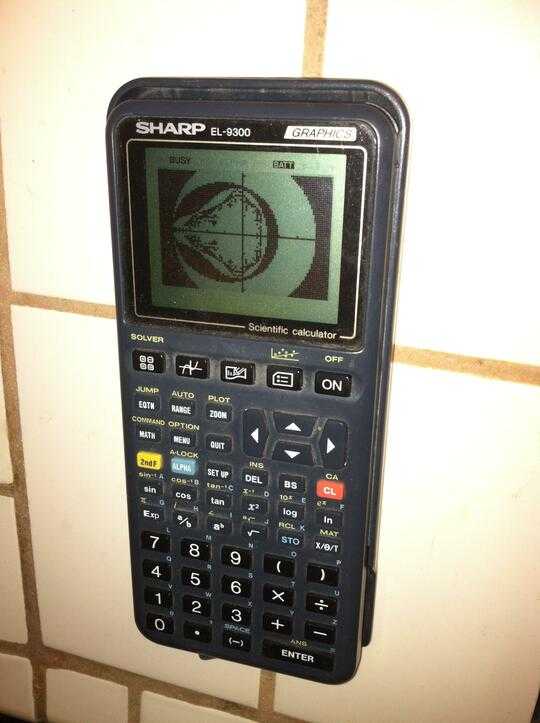

 (129 × 129)
(129 × 129)

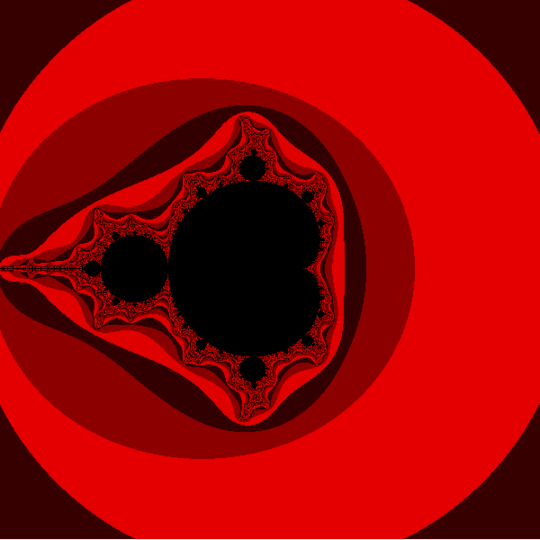

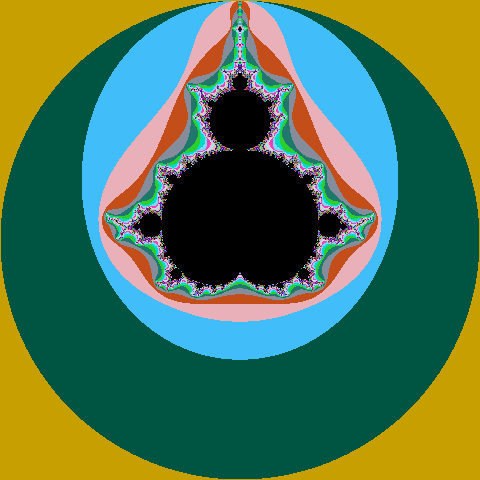
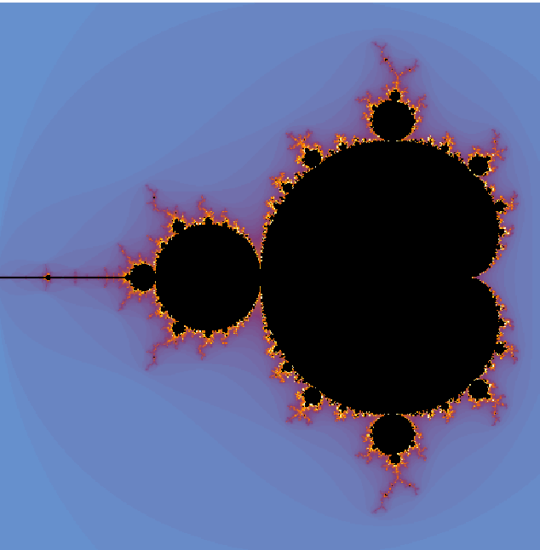
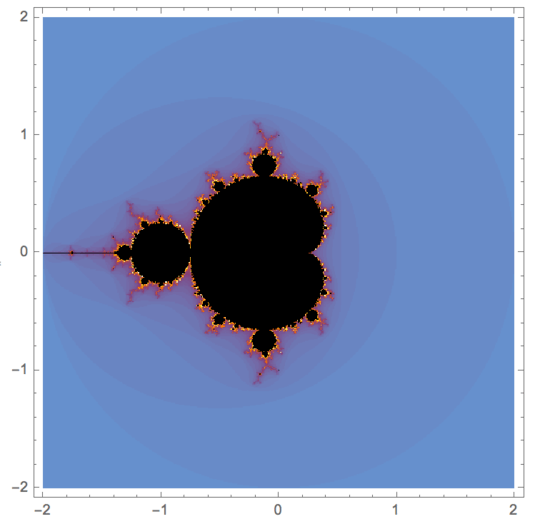

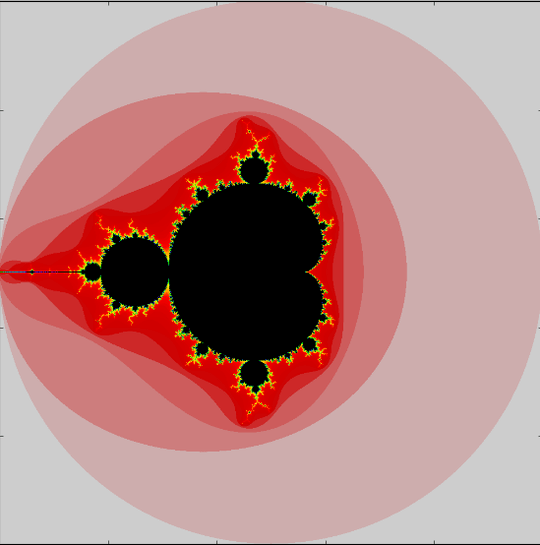


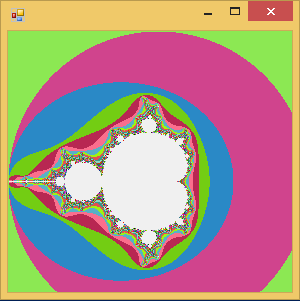
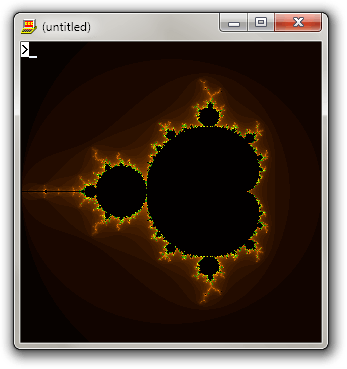
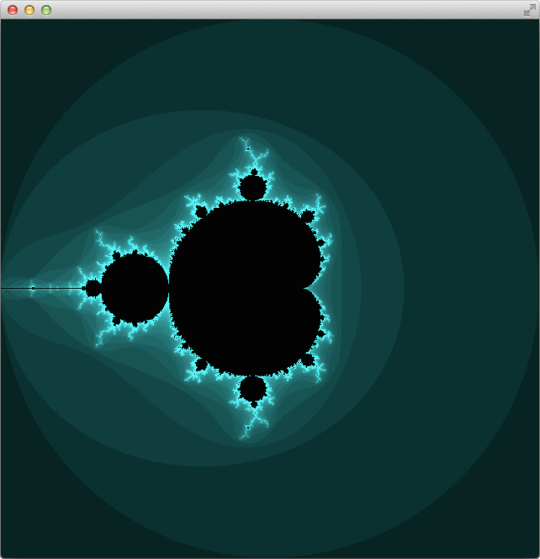
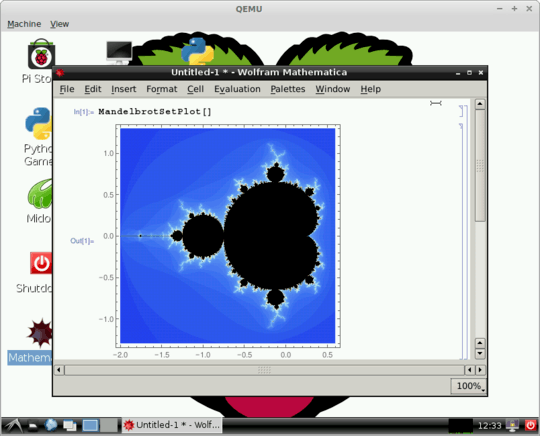
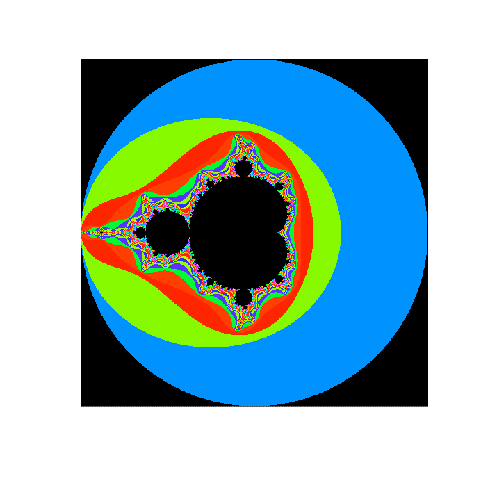


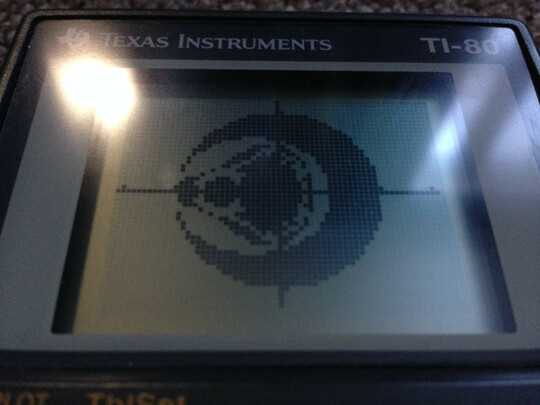

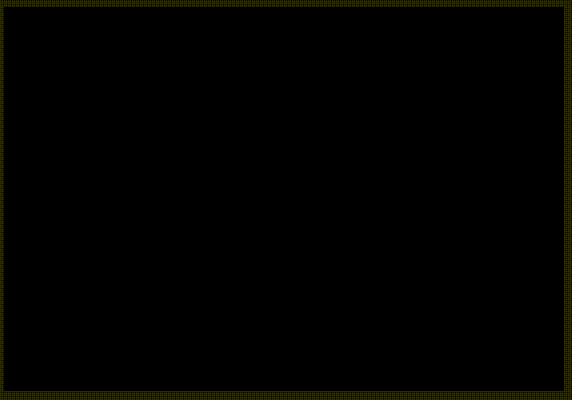


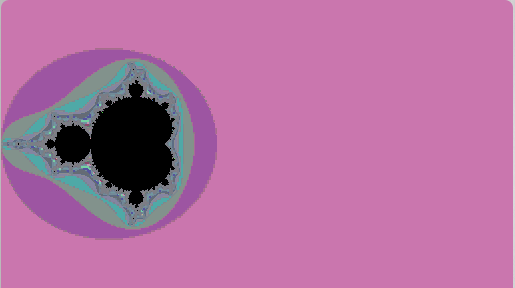
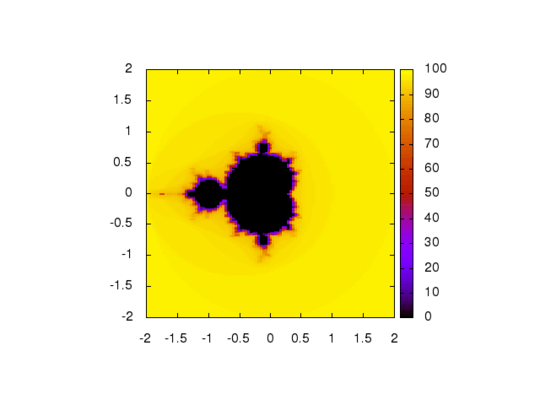
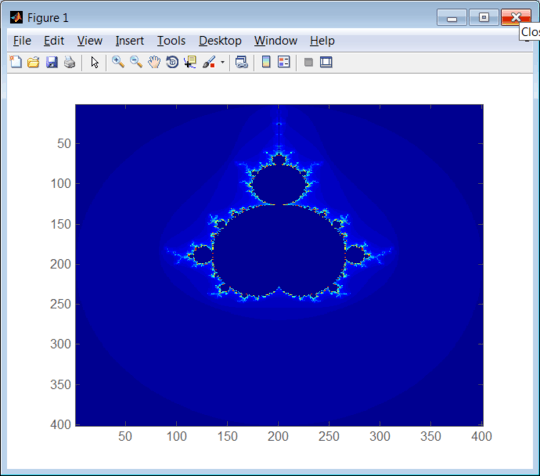
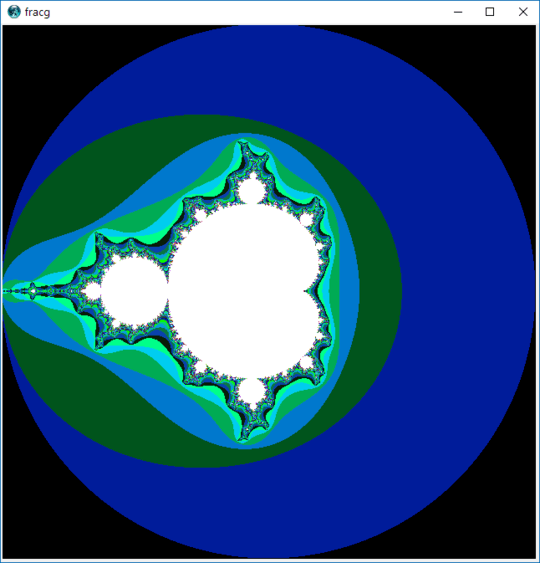
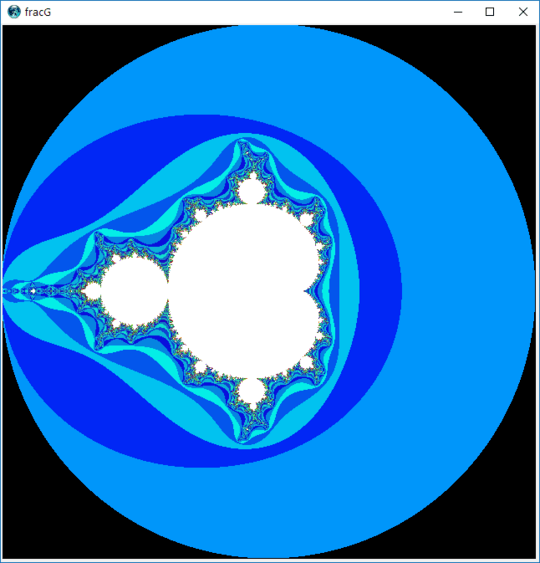

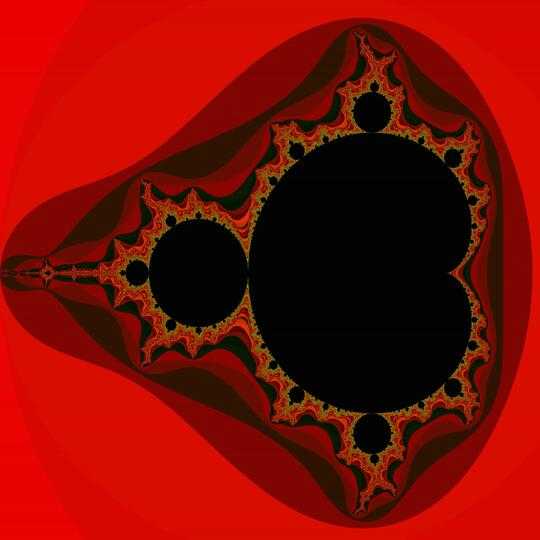
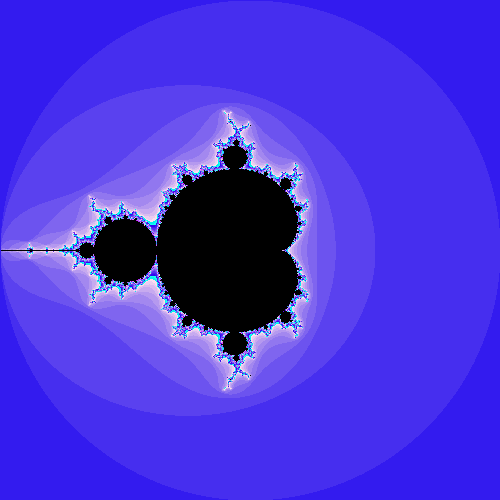

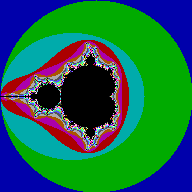

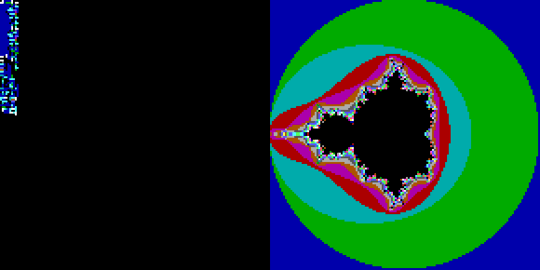



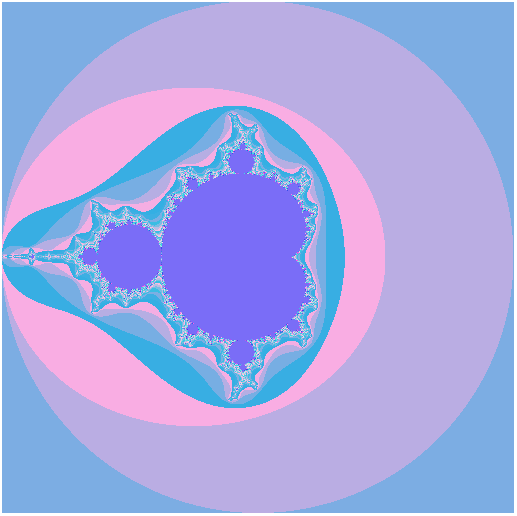
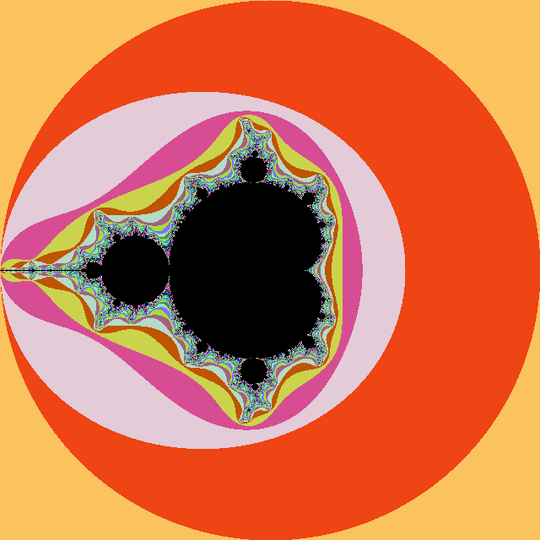
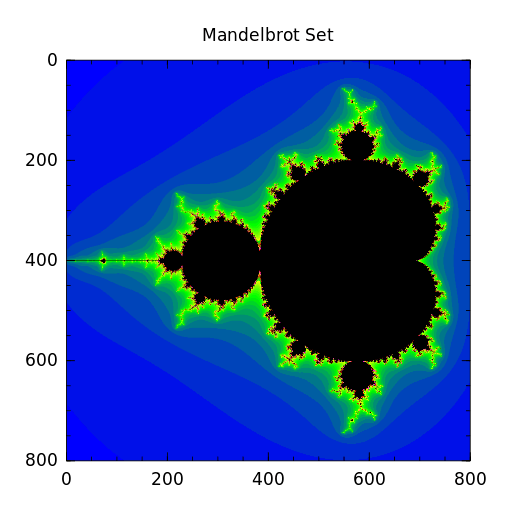
@CharlesStaats: for me it is harder to make neighboring colors easily distinguishable. – sergiol – 2017-03-19T16:55:54.120
I've noticed a curious pattern. At the 0-indexed iteration 3 the shape invariably seems like a bike saddle. – sergiol – 2017-03-21T20:34:44.733
Not mine and not golfed, but this code is a marvel of obfuscated python producing a mandelbrot fractal
– Aaron – 2017-05-26T08:37:16.310Does my HP42s have enough pixels to do this within the rules?
– SIGSTACKFAULT – 2017-09-28T13:00:46.383Read the asterisk – Mark Jeronimus – 2017-09-28T14:19:54.883
8"Easily distinguished by the eye" is hard to make objective. ...Also, apart from your personal association of the two, the Mandelbrot set has nothing to do with Hello World, so it's best to omit that from the title unless you are deliberately trolling the search engines. – Jonathan Van Matre – 2014-03-07T21:50:47.857
I'm just trying to discourage using sequential rgb indices. Thx about the title. I forgot to double-check that after finishing writing. – Mark Jeronimus – 2014-03-07T22:13:07.043
1
Related: ASCII Mandelbrot (although some of the answers posted there aren't ASCII and could probably fit better as answers to this question).
– Peter Taylor – 2014-03-07T22:44:41.793Why do you require that neighboring colors be easily distinguishable? Making them vary continuously (but still be distinct) is actually much harder. – Charles Staats – 2014-03-08T18:54:13.297
3I've seen a few people now mentioning that they render the Mandelbrot as a "Hello World". I've done that too, for something like 30 years. The Mandelbrot is the perfect "Hello World" because it shows both that you have pixel access to the display and gives a good feel for compute bound performance on the new platform. – Roger Dahl – 2014-03-09T02:00:10.367
6Great idea to ask a question which requires a combination of mathematical and aesthetic sensitivities, then impose all the the design decisions in advance. – jwg – 2014-03-10T08:25:08.743
3Anyone manages to make one in brainfuck WINS, I'd say :D – MadTux – 2014-03-10T18:45:12.470
@Charles Staats: because the brot would become too dark or too plain (see my example). Also noone will try the 'harder' things because they will always increase the code size. – Mark Jeronimus – 2014-03-10T19:17:40.557
1@jwg that's because it's a rosetta-stone and not an art contest. – Mark Jeronimus – 2014-03-10T19:18:01.647
I get what it is. I am pointing out what it should be. – jwg – 2014-03-11T12:29:54.453
1Instead of refusing to "accept" an answer, the way I usually like to run a golfing contest is to accept the shortest answer at the time, and commit to updating the tick should a shorter answer come in later. That way, people actually have a (15 rep) motivation to post the shortest answer. – Chris Jester-Young – 2014-05-30T10:07:38.457